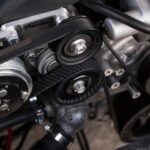Modern vehicles are equipped with various protective components, and the engine splash shield, sometimes referred to as a splash guard or skid plate, is one such crucial element. Positioned beneath the engine bay, this shield safeguards the engine and crucial components from debris, dirt, and potential damage. However, situations arise where the engine splash shield might hang down or become dislodged, posing potential risks to both the vehicle and its occupants. In this article, we explore the causes behind an engine splash shield hanging and the solutions to address this issue effectively.
1. Fastenings Can Fail
The most common cause of a hanging engine splash shield is fastening failure. The clips and bolts securing the shield can become brittle over time, especially if they are made of plastic. These fasteners are susceptible to damage from curbs, obstacles, and debris, leading to an inability to support the shield adequately.
2. Corrosion
Metal splash shields, while durable, can succumb to corrosion due to exposure to salt and moisture. This corrosion weakens the fastening points and the shield itself, eventually causing it to hang or break.
3. Poor Installation
Incorrect installation during mechanical work can result in an insecurely attached engine splash shield. Poorly secured fastenings may lead to the shield working itself loose over time.
4. Single Event Damage
The impact from misjudging curbs or driving over obstacles can cause severe damage to the splash shield, potentially ripping it from its mountings or creating holes in the shield.
5. Long-Term Damage
The shield’s purpose of deflecting debris exposes it to continuous punishment from the road surface and the engine. Over time, it can weaken and break, hanging down or detaching entirely.
6. Excessive Vibration
Frequent travel over rough terrain or unpaved roads can lead to vibrations that loosen the shield’s brackets. As vibrations persist, the shield may eventually shake loose and come away from its mountings.
Comparison Table:
| Cause | Description |
|---|---|
| Fastenings Can Fail | Clips and bolts become brittle, failing to support. |
| Corrosion | Metal shields corrode, weakening fastening points. |
| Poor Installation | Incorrect installation leads to insecure attachment. |
| Single Event Damage | Impact from obstacles can rip or damage the shield. |
| Long-Term Damage | Continuous exposure weakens shield, causing hanging. |
| Excessive Vibration | Vibrations loosen brackets, making the shield shake. |
Solutions for Hanging Engine Splash Shields
- Refitting: Check for damage and secure the shield with new fasteners if necessary;
- Repair: Restore mounting points using fiberglass or welding for plastic or metal shields, respectively;
- Replacement: If worn out or severely damaged, replace with a suitable replacement part;
- Essential Component: The shield plays a vital role in protecting the engine from debris and potential damage.
Detecting a Hanging Engine Splash Shield
An engine splash shield is a protective component designed to safeguard the engine and its surrounding parts from dirt, debris, and potential damage. When this shield hangs or becomes dislodged, it not only compromises the vehicle’s safety but also indicates underlying issues that need attention. Here are some signs to watch out for to detect a hanging engine splash shield:
- Unusual Noises: One of the most noticeable signs of a hanging splash shield is the sound it produces. If you hear scraping, rattling, or dragging noises from the undercarriage while driving, it’s likely that the shield is hanging down and coming into contact with the road;
- Reduced Ground Clearance: A hanging splash shield can lead to a decrease in ground clearance. You might notice that the front of your vehicle appears lower than usual, or that it has difficulty navigating speed bumps or uneven surfaces;
- Visible Damage: Inspect the underside of your vehicle when parked. If you notice visible damage to the splash shield, such as cracks, dents, or signs of scraping, it’s an indication that the shield is not properly secured;
- Excessive Vibration: If you feel unusual vibrations through the steering wheel, pedals, or seats while driving, it could be due to the hanging splash shield vibrating against the road surface;
- Warning Lights: Some modern vehicles are equipped with sensors that monitor various components, including the splash shield. A hanging shield could trigger warning lights on your dashboard, indicating a problem.

Addressing a Hanging Engine Splash Shield
If you suspect or detect a hanging engine splash shield, it’s essential to address the issue promptly. Ignoring a hanging shield can lead to further damage, increased risks, and potentially costly repairs. Depending on the severity of the issue, consider the following steps:
- Visual Inspection: Park your vehicle on a level surface and visually inspect the underside. If you confirm that the splash shield is hanging, assess the extent of the damage;
- Temporary Fix: If the shield is only partially hanging or slightly dislodged, you might be able to temporarily secure it back in place using zip ties or sturdy wire. However, this is not a long-term solution;
- Professional Assessment: For a comprehensive solution, consult a professional mechanic. They can assess the damage, determine whether repair or replacement is necessary, and perform the required work;
- Preventive Measures: To avoid future instances of a hanging engine splash shield, practice cautious driving and avoid rough terrain whenever possible.
Conclusion
In the realm of automotive maintenance, overlooking the engine splash shield’s condition can lead to unforeseen consequences. This inconspicuous yet crucial component plays a pivotal role in protecting your engine from the perils of the road. As we’ve explored the causes, signs, and remedies for a hanging engine splash shield, it becomes evident that its proper functioning is intertwined with your vehicle’s overall health and longevity.
From fastening failures to corrosion concerns, each cause underscores the need for vigilance and proactive measures. By understanding the signs of a hanging shield—audible warnings, diminished clearance, visible damage, and more—you can respond promptly to ensure your vehicle’s safety and optimal performance. Whether through temporary fixes, professional assessments, or preventive strategies, addressing a hanging splash shield is an investment in your vehicle’s well-being.
As you navigate the intricacies of automotive care, remember that even seemingly minor components like the engine splash shield play a substantial role in preserving your vehicle’s reliability. Regular inspections, cautious driving, and timely repairs are the keys to maintaining an intact and secure shield that shields your engine from harm.
In your journey as a responsible vehicle owner, let the lessons learned here remind you that safeguarding your engine goes beyond aesthetics—it’s about enabling your vehicle to traverse the road ahead with confidence and security.
FAQ
While you can drive with a hanging splash shield for a short distance, it’s not recommended. The shield protects vital components, and driving without it can lead to damage and increased risks.
The cost varies depending on the make and model of your vehicle, as well as whether you choose a metal or plastic shield. Replacement parts can range from $25 to $250.
If you have the necessary skills and tools, you might be able to repair minor damage. However, significant damage might require professional repair or replacement.
Regular visual inspections, especially after driving on rough terrain, can help you detect any issues with the splash shield.











